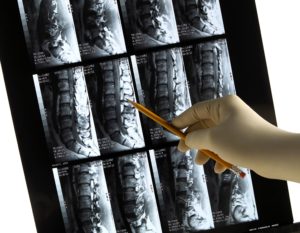In order to determine the exact cause of your back pain, your physician may recommend a discogram. While most of us are familiar with X-rays, CT scans, and MRIs, a discogram may be a new concept to you. The main difference is that while other types of imaging may be helpful in identifying the possible cause of your back pain, a discogram can confirm it.
What is a Discogram, and What Can I Expect During the Test?
Unlike other imaging techniques, a discogram is an invasive procedure that stimulates a sense of pain in spinal cord discs in order to determine the precise location that is causing pain.
During the test, a special dye is injected into discs to make each one visible on a fluoroscopy monitor, and X-rays are taken as this occurs. If a disc is healthy, you likely will not feel notable pain during the injection. If you do feel pain at a certain point, that particular disc is likely to blame for some or all of your back pain.
Additionally, the dye should remain in the place of injection within each disc, but if the dye spreads, it’s a sign that the disc may be damaged.
Is a Discogram Painful?
If you regularly experience back pain, the pain during the test is similar to what you would feel on a typical day, not much worse. The test lasts up to an hour, and the doctor may give you an antibiotic beforehand to prevent infection Statistik beratung. You will be awake during the procedure, but you may be given mild sedatives to help you relax.
You should have someone drive you home after the test, and you may feel some pain for about a day afterward.
What is the Difference Between a Discogram and an MRI?
An MRI, which stands for magnetic resonance imaging, can provide a 3D image of a certain area of the body. Through the MRI, radiologists can obtain a wealth of information, such as pinpointing discs that may be damaged.
If you have been experiencing back pain, an MRI may be all you need to answer questions about the cause of your pain. Additionally ghostwriter diplomarbeit, an MRI is a non-invasive imaging procedure, while the discogram is much more involved.
However, a discogram may provide additional information that an MRI cannot. Namely ghostwriter bachelorarbeit, the discogram can confirm the exact source of the pain through the pain stimulation technique.

The difference between a discogram and an MRI, such as the one shown here, is that a discogram can confirm the source of back pain.
Are There Any Risks Associated with a Discogram?
Like many other medical procedures, there are some side effects and typical recovery periods you may expect, as well as some risks you should be aware of beforehand ghostwriter deutschland.
Mild side effects include headaches, bruising, and soreness in the area for about 24 hours after the test.
If you experience any of the following more serious issues contact your doctor immediately:
- Signs of an infection, such as swelling, redness, fever ghostwriter agentur, and skin in the area that is unusually warm to the touch
- Long-lasting, strong headaches
- Allergic reaction to the dye
Perhaps the most significant risk associated with a discogram is injury to the nerves or blood vessels around the spine, although the risk of this occurring is extremely low.
For more information about what a discogram is and what you can expect before, during, and after the test, contact Insight Surgical Hospital’s Pain Clinic online or call us at (81–0) 2260076.


Recent Comments